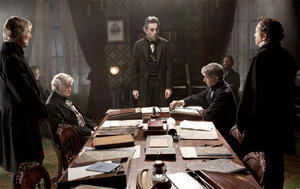Daniel Day-Lewis plays our sixteenth president in 'Lincoln'
'Lincoln' could be more daring but shines a light on the backroom shenanigans that went into abolishing slavery.

Daniel Day-Lewis (center) portrays president Abraham Lincoln as he struggles to abolish slavery.
David James/Dreamworks/AP
Steven Spielberg’s “Lincoln,” written by Tony Kushner, attempts to memorialize our 16th president without turning him into a statue. This is a tricky business. Too much reverence and you end up with waxworks. Too little and you get “Abraham Lincoln: Vampire Hunter.”
To Spielberg’s credit, he doesn’t go the great-moments-in-history route, at least not altogether. Although I wish “Lincoln” were considerably more daring both as a piece of filmmaking and as an evocation of history, it does a creditable job of delineating the horse-trading and backroom shenanigans behind one of the most momentous of all American political passages.
The movie focuses on the four months at the end of the Civil War, when Lincoln was determined to pass the 13th Amendment to abolish slavery. It ends with the war’s conclusion and Lincoln’s assassination days later.
By telescoping Lincoln’s life so drastically, Spielberg and Kushner are trying to make these singular events emblematic of the man. We are supposed to see all of Lincoln in those four supremely trying months. And certainly we can register the imprint of the ordeal on the president through Daniel Day-Lewis’s portrayal. (He resembles the wartime Lincoln of Mathew Brady’s photographs.) Lincoln remarks at one point that being president has aged him 10 years, and he’s being charitable.
But Day-Lewis is far too wily an actor to simply give us a stooped, woebegone Lincoln and leave it at that. He employs a high, wavering voice (apparently historically authentic) as a subtle, wheedling instrument. Lincoln’s Shakespeare-quoting country lawyer act, often involving the spinning of folksy yarns to the eye-rolling exasperation of his listeners, is an artful guise. He is fully capable of rage, but he parcels it out opportunely, when no other option will do. Lincoln’s complicated attitudes toward slavery and the emancipation of blacks are streamlined and cleaned up for popular consumption (as opposed to, say, their treatment in Gore Vidal’s controversial novel “Lincoln”), but there is one scene near the end that I’m glad made it into the movie: Asked by Mary’s dressmaker, Elizabeth Keckley (Gloria Reuben), whether he accepts blacks as equals, he equivocates by saying he does not know her or her people, but that, since, like everybody else, they are “bare, forked animals” (a reference to “King Lear”), he will get used to them. This tarnish to his halo has a welcome sheen. It desanctifies him.
Day-Lewis’s Lincoln is the spiritual center of the film, but he’s ringed by a multitudinous cast of characters, including David Strathairn as trusted Secretary of State William Seward; Sally Field as ramrod-tough, clinically depressed first lady Mary Todd; and, most scene-stealingly, Tommy Lee Jones as the incendiary, imperially grumpy abolitionist Republican Congressman Thaddeus Stevens.
Whenever Jones is on screen, the film’s energy level kicks up several notches, an indication, I think, that Spielberg otherwise overdoses on directorial decorum. Without any obvious opportunities for cinematic pyrotechnics – the scenes of battle and mayhem are few – he goes in for a studied, golden-age-of-Hollywood approach. We see lots of talking heads in well-appointed halls and gloomy chambers. The camerawork is relatively stationary. (“Amistad,” which also suffered from stasis, had more movement.) Spielberg is so determined not to goose this narrative about the fate of human dignity that he damps down his best strength: his ability to make history seem contemporaneous through the sheer verve of storytelling.
Part of the problem, of course, is all these famous actors strutting around in wigs and beards and bonnets. But that might not have been an impediment if the characters were brought more vividly, more rudely, to life.
The marital rift scenes between Lincoln and Mary reach for gravitas, but too often they have the effect of making Lincoln seem more henpecked than hounded. Only in Jones’s performance do we glimpse what this movie might have been – a deadly serious burlesque about matters of great moment.
Spielberg’s films have often, if indirectly, been about the consequences of absent fathers on a family. There are times in “Lincoln” when our not-always-entirely honest Abe is, in a sense, absent to himself. In some of the film’s most mysteriously moving sequences, he appears while in mixed company to suddenly waft into some dark and private precinct. When Spielberg allows these silences – when, for example, he simply shows Lincoln slowly sauntering away from us down an unpeopled corridor – the film achieves a spooky eminence. Suddenly it becomes more than a history lesson, however well crafted and researched. It becomes a meditation on the unknowability of great men, of all men. Grade: B (Rated PG-13 for an intense scene of war violence, some images of carnage, and brief strong language.)

